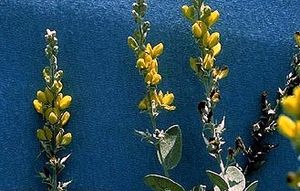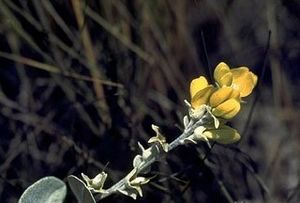Hairy rattleweed facts for kids
Quick facts for kids Hairy rattleweed |
|
|---|---|
 |
|
| Conservation status | |
| Scientific classification | |
| Kingdom: | |
| (unranked): | |
| (unranked): | |
| (unranked): | |
| Order: | |
| Family: | |
| Genus: |
Baptisia
|
| Species: |
B. arachnifera
|
| Binomial name | |
| Baptisia arachnifera W.H.Duncan
|
|
The Baptisia arachnifera, also known as hairy rattleweed or hairy wild indigo, is a special kind of flowering plant. It belongs to the legume family, which includes peas and beans. This plant is an endangered species, meaning it's at risk of disappearing forever.
You can only find this plant growing naturally in sandy soils. It lives in pinewoods along the coastal plain of Georgia in the United States.
Contents
What is Hairy Rattleweed?
This plant is a perennial, which means it lives for more than two years. It can grow to be about 40 to 80 centimeters tall. That's roughly the height of a two-liter soda bottle!
The plant is covered with soft, grayish-white hairs. These hairs make it look a bit like it's covered in cobwebs.
Leaves and Flowers
The leaves of the hairy rattleweed are blue-green. They are simple, meaning each leaf is just one piece. They are also heart-shaped and grow alternately along the stem. Each leaf is usually 2 to 6 centimeters long and 1.5 to 5 centimeters wide.
Its bright yellow flowers grow in clusters called racemes. These flowers usually bloom in late June through early August.
Fruits and Seeds
After the flowers bloom, the plant produces fruits. These are woody pods, about 8 to 15 millimeters long and 6 to 9 millimeters wide. They have small stalks and beaks. The fruits usually form between August and October.
Who Discovered This Plant?
A scientist named Wilbur Howard Duncan first described the hairy rattleweed in 1944. He had collected a sample of the plant two years earlier, in 1942. He found it in Wayne County, Georgia.
Where Does It Live and How Is It Protected?
Sadly, most of the places where this plant used to grow have been destroyed. About 95% to 99% of its original home has been cleared. These areas were often replanted with large plantations of pine trees.
Now, the hairy rattleweed only grows in small patches. You can find it among these pine tree stands, in nearby forests, and sometimes even along roadsides.
Protecting the Plant
The U.S. Fish and Wildlife Service has listed Baptisia arachnifera as an endangered species since 1978. This means it has special protection under the law. It is only known to grow in two counties in Georgia: Brantley and Wayne.
One way to help this plant is through prescribed burning. This is when experts carefully set small fires in certain areas. These fires can help the plant by clearing away other plants that might compete with it for sunlight and space. A timber company called Rayonier even received an award for using prescribed fire to help protect this species.



